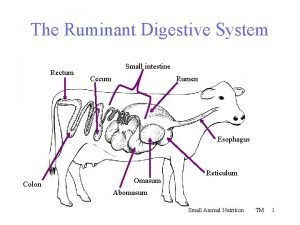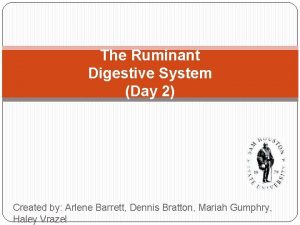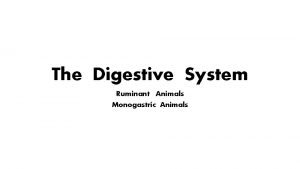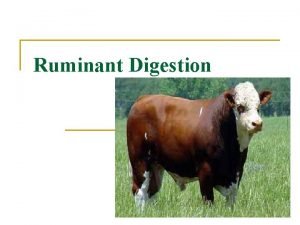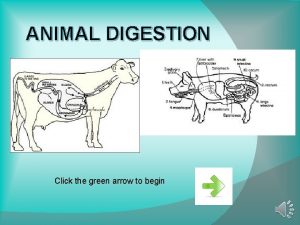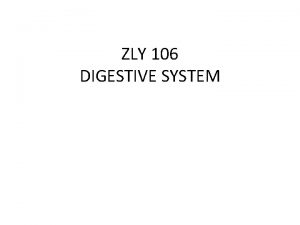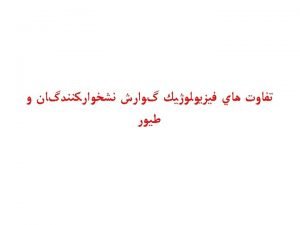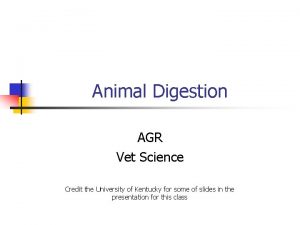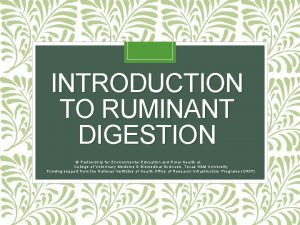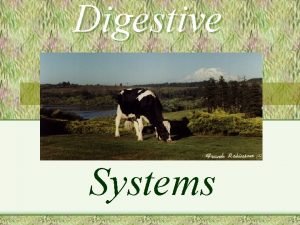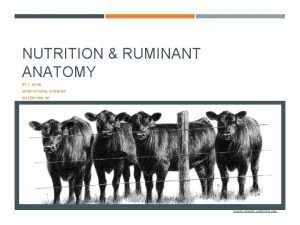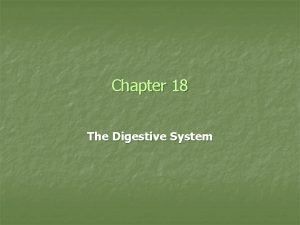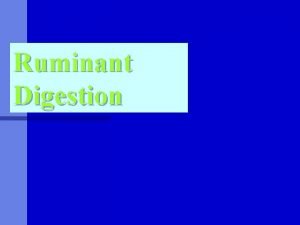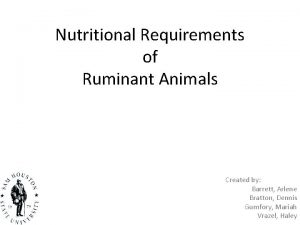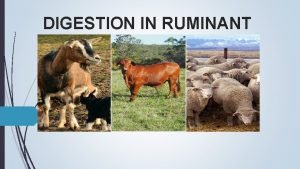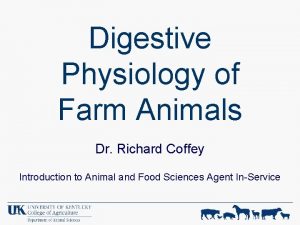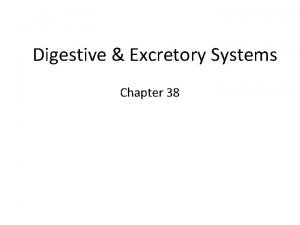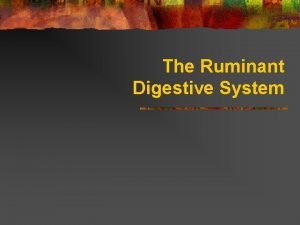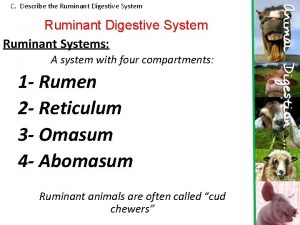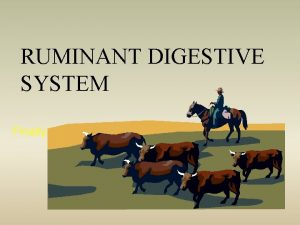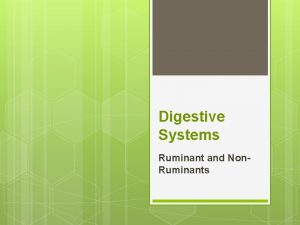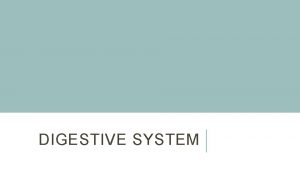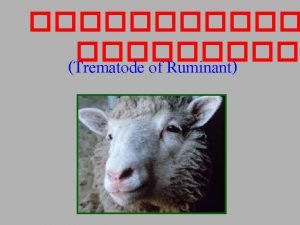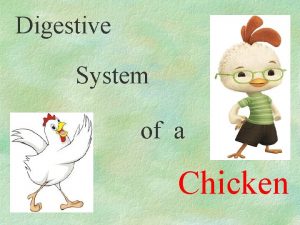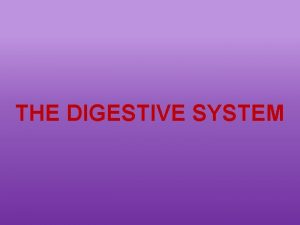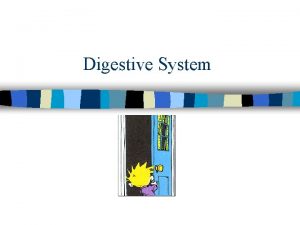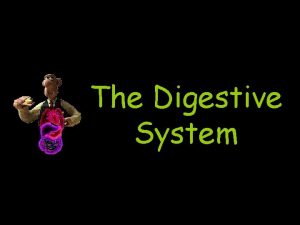The Ruminant Digestive System Nutrition Ruminant Digestive Systems























- Slides: 23

The Ruminant Digestive System & Nutrition

Ruminant Digestive Systems n The digestive system changes food nutrients into compounds that are easily absorbed into the bloodstream.

Ruminant Digestive Systems Ruminants are those animals that contain a multi-chambered digestive system n Cattle gain the majority of their nutritional needs from forages and other roughages. n n Forage refers to grasses, roughages refers to other high-fiber food sources.

Ruminant Digestive Systems n Non-ruminant animals cannot obtain the nutritional value from most plant sources unless the food has been modified (ground, mashed, etc. )


Ruminant Digestive Systems n The digestive system of ruminant animals starts with: n n Mouth, Teeth, & Tongue Followed by: n Pharynx & Esophagus

The Ruminant Stomach n Rumination: • Ruminants are known for “cud chewing” • Rumination involves: n Bolus of previously eaten feed carried back into the mouth by reverse peristalsis n Fluid in bolus is squeezed out with the tongue and re-swallowed n Bolus is re-chewed and re-swallowed

Ruminant Digestive Systems n n While the animal is “chewing its cud” foreign particles that are heavy are allowed to “sink” in the reticulum, preventing many foreign particles from entering the rest of the digestive system. Once foreign material enters the reticulum, it stays there for the life of the animal.

Ruminant Digestive Systems n At this point, ruminant animals have a multi-chambered “stomach” n Rumen – the organ that allows for bacterial and chemical breakdown of fiber to gain the proteins and energy from plant sources.

Ruminant Digestive Systems n The rumen has a very thick, muscular wall. n It fills most of the left-side of the abdomen n In cattle the rumen can have a capacity of up to 55 -65 gallons! n Normal 25 -30 gallons

Ruminant Digestive Systems n The walls of the rumen contain papillae (that can be up to 1 cm. in length), where the bacteria that are used to breakdown fiber live.

Papillae in Rumen

Papillae in Rumen

Ruminant Digestive Systems n Next the feed moves into: n Reticulum - honeycomb-like interior surface, this part helps to remove foreign matter from the food material.

Reticulum - full

Reticulum - cleaned

Tripe = Delicious?

Ruminant Digestive Systems n Omasum - section that is round and muscular. n“Grinds” the food material and prepares the food material for chemical breakdown.


Ruminant Digestive Systems n Abomasum - The true, glandular stomach very similar to the stomach of non-ruminants. nthis is where the majority of chemical breakdown of food material occurs. nmixes in digestive enzymes (pepsin, rennin, bile, etc. ).

Ruminant Digestive Systems n Followed n. Small by: Intestine Large Intestine Colon Rectum Anus

Digestive Tract – Bovine

Group Assignment n n Create a model of a ruminant digestive system Must contain all parts listed on chart below Rectum Small intestine Pancreas Rumen Omasum Esophagus Large intestine Reticulum Cecum Liver Gall bladder Abomasum
 Ruminant digestion
Ruminant digestion Define ruminant digestive system
Define ruminant digestive system Ruminant animals
Ruminant animals Compartment of ruminant stomach
Compartment of ruminant stomach Pseudo-ruminant
Pseudo-ruminant Ruminant digestive system
Ruminant digestive system Cow digestive system
Cow digestive system Chicken digestive system
Chicken digestive system Conclusion of digestive system
Conclusion of digestive system Digestion in ruminants diagram
Digestion in ruminants diagram Ruminant animals
Ruminant animals Digestive system circulatory system and respiratory system
Digestive system circulatory system and respiratory system Nervous system and digestive system
Nervous system and digestive system Macrominerals
Macrominerals Aude ferran
Aude ferran The hepatic portal vein empties into the ____.
The hepatic portal vein empties into the ____. Ruminant animals
Ruminant animals Nutritional requirements for ruminant animals
Nutritional requirements for ruminant animals Ruminant animals
Ruminant animals Rumen reticulum omasum abomasum
Rumen reticulum omasum abomasum Section 38-2 the process of digestion answer key
Section 38-2 the process of digestion answer key Hát kết hợp bộ gõ cơ thể
Hát kết hợp bộ gõ cơ thể Slidetodoc
Slidetodoc Bổ thể
Bổ thể
